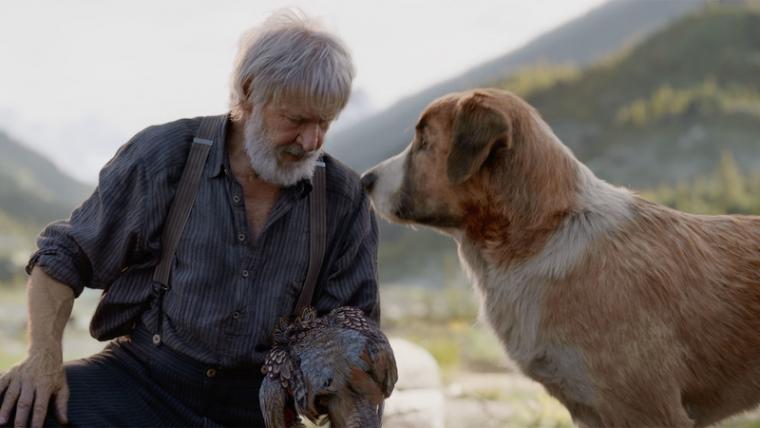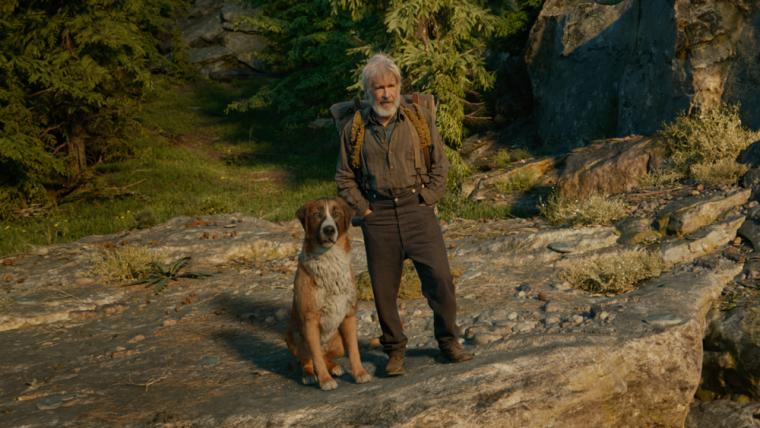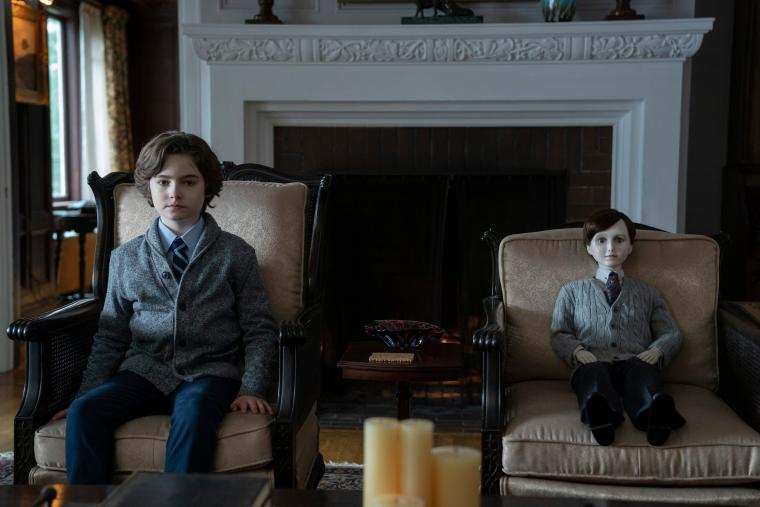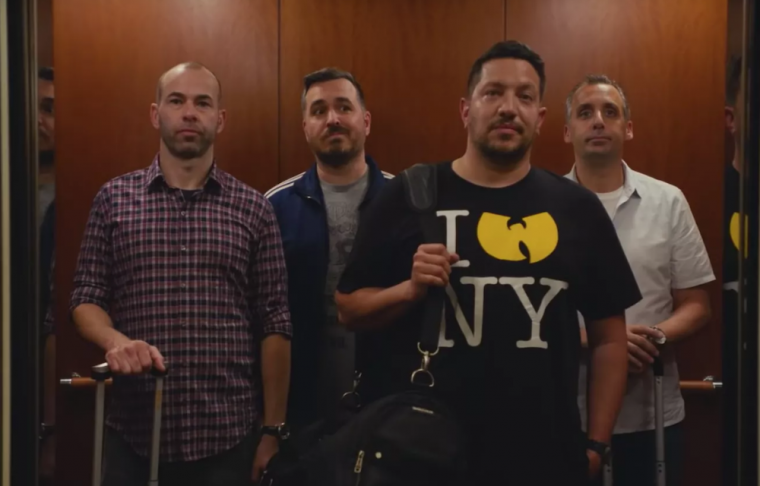
THE CALL OF THE WILD
The Call of the Wild, director Chris Sanders' adaptation of Jack London's 1903 novel, is the first 20th Century Fox film to be released under the studio's new 20th Century Studios name, and that's fitting given that you won't find an actual fox in it – nor, given the movie's heavy employment of CGI, actual dogs, wolves, or bears. It's also one of the studio's first major titles to come out since last spring's merger of 20th Century Fox and Disney, and that, too, makes sense, considering that this retelling of London's beloved adventure saga is so breathtakingly Disney that a cameo by Mickey Mouse wouldn't be completely inappropriate.
Yet the happy surprise of Sanders' achievement is that it's good Disney – or at least totally-decent Disney – in the vein of so many live-action touchstones from the '50s and '60s: Treasure Island, Swiss Family Robinson, 20,000 Leagues Under the Sea, Darby O'Gill & the Little People. In both figurative and nearly literal terms, this Call of the Wild is sometimes staggeringly cartoonish, particularly in regard to our heroic St. Bernard/Scotch shepherd mix Buck, a CGI creation who's every bit as facially expressive as The Lion King's Simba – and I mean the animated Simba from 1994, not the vacantly staring cub from last summer's mega-hit. Once you adjust, however, to Buck's initially off-putting quality, and the similar anthropomorphism of the film's other animals, and the intentional broadness of everything from the compositions to the choreography to the humans, Sanders' outing emerges as an unexpectedly winning and effective family flick. The wide-screen vistas and gripping action sequences make seeing it at the cineplex preferable, but don't fret if you miss the movie now – once it lands, it'll be a go-to choice on Disney+ forever.
While some plot points have been changed or excised completely, this is still much the same tale London told 117 years ago, with the canine behemoth Buck, during the 1890s Gold Rush, separated from his cushy existence in California and taken to the Yukon, first serving as a mail-carrier sled dog, and then as traveling companion to grizzled loner John Thornton (Harrison Ford). Long before Buck's Canadian tenure begins, though, Sanders gives us plenty of opportunities to study this lumbering yet astoundingly fleet and agile beast with a penchant for comic mayhem, and the extended intro proves necessary. Not only does it immediately clue us in to Sanders' overall approach to the movie – heavy sentiment infused with moments of toughness and a dollop of slapstick – but it allows us to really familiarize ourselves with Buck's face, through which most of London's (and screenwriter Michael Green's) story will be told.
Admittedly, when I first caught a preview for the film at Christmas, I was aghast: Buck's expressions of confusion, fear, joy, et cetera were so blatantly computer-generated, so impossible for any kind of flesh-and-blood dog, that Sanders' offering, right from the start, felt like an inevitable debacle – a work that would prove an offense to London's prose, to audiences, and to animals. Yet the more I stared at Buck when watching the movie in full, the more his human countenance grew on me, mostly because it was proving a perfect match for the storytelling.

The early scenes in which Buck tore through his master's house, rattling every unstable object in sight, and devoured a fancy picnic feast were so abjectly unreal that they needed an equally unreal protagonist to be in any way funny; without the big-eyed CGI of this faux pup, it would just be tepid A Dog's Journey schtick all over again. Buck's voiceless reactions give Sanders' and Green's gags force and payoff – my fellow patrons frequently roared with laughter and were right to – and somewhat amazingly, they prove just as beneficial to the film's sentimental leanings. With an actual dog forcibly crated up and taken from his home, it would be easy to feel unduly manipulated by the sight, especially with composer John Powell's score assaulting our tear ducts. Here, though, witnessing Buck's forlorn expressions as he's carted away or endures later hardships, you can accept these scenes as sturdy cinematic melodrama rather than abuse; because this Buck isn't in any way real, you don't spend any time worrying about potential suffering, and are able to enjoy London's adventure the way you're meant to. (It makes absolute sense that PETA tweeted its support for the movie, saying, “The beautiful visuals prove that you can make a film all about animals without exploiting a single one.”)
Freed from many of the constraints of realism, Sanders, whose sole Hollywood-feature credits until now have been animated works, shapes his “live-action” Call of the Wild sequences with the speed and zest of first-rate animation: Buck and his dog-sled team navigating treacherous Canadian terrain and delivering mail at unheard-of speeds; Buck saving a wolf from drowning by single-handedly (paw-edly?) shifting a fallen tree; Buck engaging in a vicious mountaintop battle with a rival alpha male. And with the dog's fellow animals also CGI creations with recognizably human ways of expressing themselves, London's narrative has been made both accessible and understandable to very young viewers weaned on the Disney catalog – a technique that doesn't defy the essence of London's novel so much as clarify it, at least in this context. Sanders' offering is like the Disney-flick equivalent of crisp, clean prose, making points without belaboring the obvious and earning your affection through utter sincerity. Harrison Ford's performance, come to think of it, does the exact same thing.
Does any other living film actor carry with him the intensity of audience goodwill amassed by Ford? (Okay, maybe Tom Hanks, but he hasn't been around as long.) Even when the actor is in a sub-par project, our affection for him is inseparable from our memories of Han Solo and Indiana Jones and all the other endearingly gruff rascals Ford has played over the decades, and Call of the Wild takes full advantage of our adoration. Sure, his voice-over narration is unnecessary, especially with Buck's and company's faces now doing so much of the tale's expositional heavy-lifting. But while Ford has always been a masterfully subtle actor, his advancing years have only made him more offhandedly commanding and richly textured, and he's thunderously enjoyable in this role that basically amounts to a one-man show – or would if the CGI canine opposite him weren't proving an ideal scene partner. You absolutely feel John Thornton's loneliness, desperation, and grief, and consequently feel all the more elated when Buck's arrival puts visible fire in the old man's eyes; for all of its melancholy, there's as much legitimate joy in Ford's portrayal here as there was in his exhilarating Force Awakens return. The Call of the Wild is worth seeing for both its central dog and central human, and the movie's strengths are more than enough to make you forget about the prevailing air of Disney blandness and unmistakable air of Disney obviousness exemplified by Dan Stevens as a Yukon Snidely Whiplash. Previously, Stevens played the Beast in Disney's live-action Beauty & the Beast. Now he's pretty much playing Gaston. Toss the guy a Downton Abbey prequel, and I'm sure he'd deliver an impeccable Cogsworth.

BRAHMS: THE BOY II
It's hardly a genre pinnacle or anything, but 2016's devil-doll horror flick The Boy was just shivery and distinctive enough to make me moderately psyched for Brahms: The Boy II, despite every fiber of my being insisting that I shouldn't get my hopes up. When oh when will I start listening to my fibers? Taking place a few years after the events of director William Brent Bell's precursor, in which a nanny was terrorized by a porcelain plaything who may or may not have been alive, this follow-up finds a damaged family moving onto the British estate once occupied by the cracked, creepy Brahms. Finding this toy buried in the woods, the clan's mute young son Jude (Christopher Convery) shows an immediate and unbecoming fondness for it, and as you might imagine, nervous giggles and “Is the doll alive or not?!” scares follow. Except they really don't – at least if you've seen the original.
Not to spoil things for those of you who've spent four years meaning to get around to The Boy and never did, but despite its flaws, the movie actually makes a surprising amount of sense, explaining the Brahms mystery in ways that mostly hold up even past its finale. Brahms, however, trashes that film's logic within the first minutes of the doll's reappearance – he now moves independently when no one is around to notice – so in addition to being confused and annoyed, we Boy I admirers just wind up bored, waiting for supernatural crises that only on rare occasion transpire. (And even then they're under the dreaded bane of a PG-13 rating, so when the movie's most loathsome human gets his deserved comeuppance, it's nowhere near as grisly or satisfying as it should be.) The explanation for Jude's refusal to speak provides a relatively solid setup for this particular tale, and even though she's never been much of an actor, Katie Holmes is empathetic as the mom whose paranoia about Brahms might be linked to trauma; there's genuine conviction behind her insistence that the horrors she's experiencing aren't all in her head. Yet Brahms: The Boy II, even at only 85 minutes, is consistently redundant and depressingly fright-free, and despite the presence of reliable character creep Ralph Ineson, the only true fun I got from the film was in the presence of Owain Yeoman as the family patriarch. With his Welsh accent and uncanny resemblance, Yeoman might be the only man alive who could compete in a Christian Bale-impersonator contest against the actual Christian Bale and win.

IMPRACTICAL JOKERS: THE MOVIE
Sometimes I gotta hand it to my movie-reviewing gig: It lets me get caught up on a lot of TV. Before attending their feature-length offshoots, I had never seen a single second of Crocodile Hunter or Reno 911! or Absolutely Fabulous; after 90-ish minutes of each, I felt as though I'd spent many long, unrequested seasons in their company. Following an hour-and-a-half of director Chris Henchy's Impractical Jokers: The Movie, I also feel completely caught up on nearly 10 seasons of cruelly good-natured pranks and frequent bad taste – and as with those other “films,” it was enough to make me not for a minute regret the TV time I instead spent, you know, tidying the apartment or staring off into space.
I guess I get the appeal of a show that's like a naughtier Candid Camera and a less potentially fatal Jackass, even if the dares we're treated to here aren't particularly inspired and the four Staten Island brosefs at its core are – how to put this delicately … ? – perhaps the least telegenic feature-film stars in the history of American cinema. But while happy fans of Joe Gatto, James Murray, Brian Quinn, and Sal Vulcano were clearly at my screening, as evidenced by their verbal repetition all of the guys' “funniest” lines immediately upon hearing them, I whiled away much of my eternity at this cringe-inducing doc-comedy staring at the floor or the auditorium's beckoning “EXIT” sign – anywhere but at the grossly self-satisfied, dispiriting shenanigans on-screen. That said, I'll admit that while the “challenges” were my least-favorite segments, given that they forced us to watch the same unamusing scenarios played out four times in a row, I did smile during the bit that found our pranksters applying for jobs with the Atlanta Hawks; that routine had some bite. Otherwise, the terribly edited, product-placement-obsessed Impractical Jokers: The Movie was most definitely not for this newbie, even if it did showcase a more-than-game participant in the 57-year-old dynamo that is Paula Abdul. By the movie's end, she never wants to see her four co-stars ever again. So Paula and I finally have something in common.










